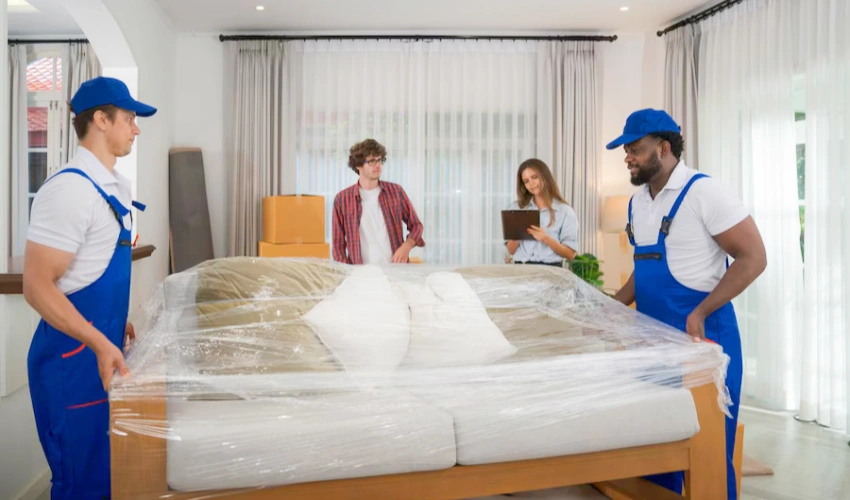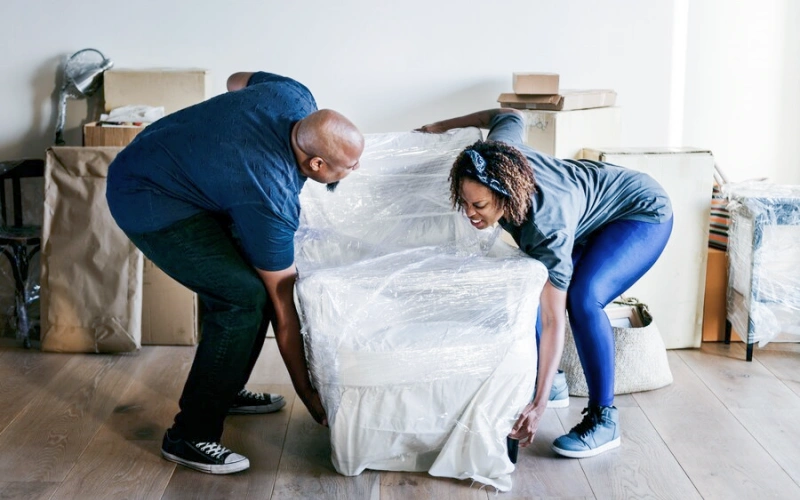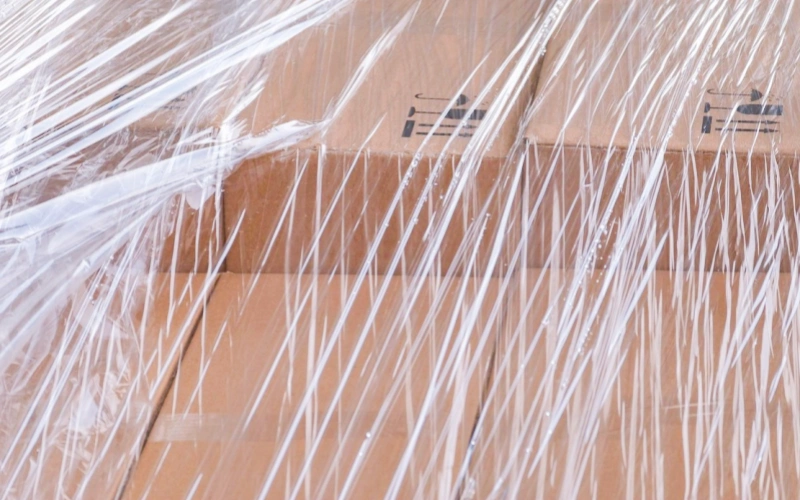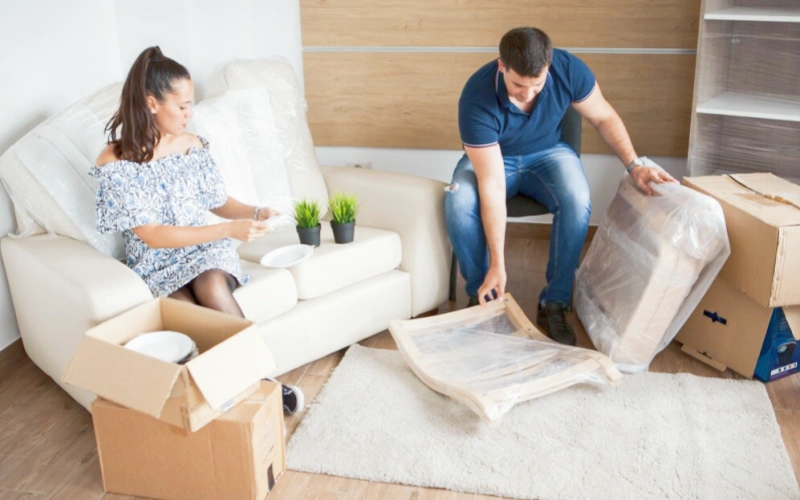
What type of damage do you worry about most when moving? Please tell us:
The day of moving should be a fresh start — but without the right protection, it can quickly turn into a nightmare. Imagine carefully disassembling your favorite wooden dresser, only to find deep scratches after unloading. Picture a rainstorm soaking your cardboard boxes mid-transit, leaving cherished photos warped beyond repair. Worse yet, envision your fragile dishes rattling loose from a poorly sealed box, shattered on arrival. These aren’t just hypothetical disasters; they’re costly realities for countless movers.
The good news? A simple, affordable tool can prevent 90% of these headaches: stretch packing cling wrap. Unlike bulky packing materials, this unsung hero furniture cling wrap offers lightweight yet industrial-grade protection against scratches, moisture, and chaos. But here’s the catch — the best stretch wrap for heavy furniture‘s effectiveness hinges on how you use it. Overwrap delicate items, and you risk crushing them. Choose the wrong thickness, and heavy furniture might tear through.
Master these 7 proven techniques, and you’ll not only shield your belongings but also slash hidden costs. Think reduced damage claims, fewer replacement purchases, and even lower insurance premiums. Whether you’re a DIY mover or hiring professionals, smart plastic cling wrap for moving usage turns “What if?” worries into confidence. Let’s dive in — your stress-free move starts with the first tip below.
Moving can be chaotic, but plastic wrap for moving furniture is a game-changer for protecting your belongings. Here’s how to use it like a pro—plus savvy purchasing tips to save time, money, and sanity:
Why it matters: Thin wraps tear mid-move, risking damage, while overly thick plastic wrap drain your budget unnecessarily.
Antique legs chip, and hardwood floors scratch easily during dragging.
TVs and consoles can crack from road vibrations. Plastic wrap alone lacks cushioning.
Heavy books or dishes can burst box seams during transit.
Mattresses absorb truck fumes, humidity, and pests.
Paper labels peel off; Sharpies fade in humidity.
Tight plastic traps moisture, ruining wood or artwork.
Plastic wrap isn’t just a tool—it’s your moving insurance. By pairing these hacks with the right products, you’ll save time, reduce damage, and turn chaos into confidence. Shop our moving essentials today and wrap your way to a smoother move!

When planning a move, you’ll incur both material expenses (e.g., moving plastic wrap for furniture) and risk-management costs (e.g., insurance). This comparison examines the upfront cost and protection level of:
| Protection Method | Unit Cost | Units Required | Total Cost | Coverage Description |
|---|---|---|---|---|
| Stretch Wrap | About $25 per roll | 4 rolls | About $100 | Protects against dust, moisture, minor scratches, and shifting; no financial payout. |
| Moving Insurance | $0.80 per $100 of declared value | 200 (i.e. $20,000 ÷ $100) | $160 | Reimburses repair/replacement costs up to $20,000 for loss or damage. |

Here are two detailed user scenario examples for plastic wrap in moving/storage situations, crafted to resonate emotionally while showcasing product benefits:
When Lisa prepared to ship her custom wrought-iron patio set from Charleston to San Diego, she worried about coastal humidity and salt spray during the two-week rail and truck journey. Late one night, she imagined the ornate scrollwork pitted with rust, the deep green powder-coat flaking off under briny fog. Determined to protect her investment, she enveloped each chair leg, tabletop, and decorative finial in our VCI Protective Stretch Film (link to product).
Exactly fourteen days later, as the crate was slid into her new sunroom, Lisa peeled back the layers to reveal the ironwork unblemished—no orange spots, no paint lifting, not even a hint of corrosion. The vapor-phase inhibitors had permeated every nook, creating an invisible fortress against salt and moisture. “It looks brand new,” she breathed, running her hand along the flawless curves of her favorite chair.
Key Product Features:
By choosing VCI Protective Stretch Film for her patio set, Lisa ensured that her heirloom-quality furniture arrived exactly as it left—ready for years of sun-soaked enjoyment without a speck of rust.
Mike’s garage smelled of motor oil and forgotten Christmases when he shrouded the 1970s velvet sofa – its cushions still dented from generations of Thanksgiving naps. Over six storage months, temperature swings built electrostatic charges that normally would’ve turned the heirloom fabric into a dust magnet.
Reopening the bundle during his divorce house sale, sunlight revealed something miraculous: The original emerald upholstery gleamed like the 1985 family photo showing his grandmother hosting bridge nights. The Anti-Static Storage Wrap’s carbon-fiber threading had neutralized 92% of particulate attraction, preserving the sofa he’d eventually gift to his niece for her first apartment.
Moving can be stressful—and the last thing you want is mountains of single-use plastic wrapping cluttering up landfills. Our environmentally friendly plastic wrap for furniture moving protection combines the protective power of traditional stretch film with sustainable design, so you can safeguard your belongings and the planet simultaneously.
Eco-Conscious Materials
Made from a high-grade blend of recycled polyethylene (rPE) and plant-derived resins, this recycled pallet wraps reduces virgin plastic use by up to 60%. The material is free from phthalates and heavy metals, and it’s fully recyclable through standard municipal recycling programs. In addition, an optional compostable version utilizes certified industrial-compostable polymers, breaking down into water, carbon dioxide, and organic biomass under commercial composting conditions.
Superior Protection & Performance
Despite its green credentials, this film delivers all the strength and clarity you expect:
User-Friendly Design
Each roll is precision-slit for consistent width and wound on a reusable core that fits most standard dispensers. The film unwinds smoothly, reducing frustration and wasted material. Its transparent finish makes it easy to identify wrapped items without removing the film.
Sustainable End-of-Life
When you’re done moving, simply peel off and recycle the wrap with other plastic films (like grocery bags) or compost the certified version. Even the shipping boxes are made from 100% post-consumer recycled cardboard, printed with soy-based inks.
Why Choose Our Eco-Friendly Clear Moving Wrap?
By selecting this sustainable wrap, you’re choosing:
Make your next move both efficient and eco-responsible—choose our environmentally friendly plastic wrap for moving.

For the best deals and guaranteed authenticity, purchase directly through our official website (https://www.pwpstretchfilm.com/). Buying from us ensures you receive the latest product innovations, access to expert advice, and exclusive bulk discounts. Plus, we offer fast shipping to keep your moving timeline on track.
By cutting out third-party resellers, we eliminate the risk of counterfeit or substandard products entering the supply chain. Every roll that leaves our facility is individually inspected and batch-tested for consistency in cling strength, puncture resistance, and dimensional accuracy. You receive exactly what our R&D team intended, with no compromise on performance or reliability.
PWP’s eco-friendly stretch films incorporate advanced resin blends that reduce material usage without sacrificing durability. Our low-gauge, high-strength formulations mean fewer rolls per job and less plastic waste overall. We also offer a take-back program for used cores, helping you close the loop on packaging materials and support your company’s circular-economy goals.
When you buy from us, you’re first in line for our latest developments—whether that’s cold-temperature cling, colored film for zone coding, or high-UV formulations for outdoor storage. These innovations are often available weeks before they reach distributors, giving your operation a competitive edge.
Our in-house technical advisors are available via live chat, phone, or email to guide you through film selection, usage best practices, and troubleshooting. They can help optimize your stretch ratio, wrapping patterns, and machine settings—so you maximize load integrity while minimizing film consumption.
We structure our pricing so that larger commitments unlock deeper savings. Volume thresholds are clearly displayed on our site, and custom quotes can be arranged for truly large orders. This transparent, quantity-driven model ensures you never overpay for the stretch film you need.
With strategically located warehouses and trusted carrier partners, we fulfill the majority of direct web orders within 24 hours. You’ll receive automated shipment notifications and tracking details the moment your order ships, so you can plan unloading and installation without disruption.
At PWP Stretch Film, we’re committed to making your move stress-free. Whether you’re wrapping a single couch or securing an entire household, our products are engineered to deliver unmatched performance. Visit one of the retailers above or reach out to us directly—we’re here to help you pack with confidence!
Yes, plastic wrap for moving is an excellent choice for protecting your belongings during a move. It is commonly used to wrap furniture, appliances, and boxes to prevent damage, dirt, and moisture. The primary benefit of using plastic wrap for moving is its ability to create a tight seal that keeps items secure and in place, which is particularly important for delicate or fragile goods. The flexibility of stretch film allows it to conform to various shapes and sizes, making it a versatile packaging material. It also helps secure loose parts such as drawers, doors, and cushions to ensure everything stays together. Moreover, plastic wrap for moving is lightweight, easy to handle, and doesn’t require special equipment—just a roll and a bit of time. However, it’s best to combine it with other materials like moving blankets or bubble wrap for added protection, especially for heavy or fragile items. While it’s not suitable for protecting sharp-edged or heavy-duty equipment, it works well for most standard household and office items.
Movers wrap furniture in plastic wrap for moving primarily to protect the pieces during transportation. It serves several purposes, with the first being protection from dirt and dust. During a move, furniture can easily pick up dust or debris, especially if it is exposed to outdoor elements or handled roughly. Plastic wrap for moving acts as a barrier that keeps these contaminants from damaging your furniture. Additionally, furniture made of wood, leather, or fabric can be vulnerable to moisture during a move, whether from rain or humidity. The plastic wrap prevents moisture from seeping in, protecting against water damage. Wrapping furniture also keeps loose parts like drawers, doors, or cushions secure, ensuring nothing gets lost or separated during the move. Furthermore, plastic wrap for moving prevents scratches, scuffs, and other surface damage that might occur when furniture comes into contact with rough surfaces or other items. This wrapping technique is cost-effective and simple to apply, offering an added layer of protection that helps keep your furniture in pristine condition throughout the entire moving process.
When choosing the right shrink wrap for moving, the gauge, or thickness, of the wrap is an important factor to consider. A thicker gauge provides greater durability and strength, which is crucial for heavier or bulkier items. For lighter, smaller moves, a 60 gauge shrink wrap is usually sufficient. This thinner wrap works well for lightweight furniture or smaller household items but may not provide enough protection for heavier pieces. If you’re moving standard-sized furniture or appliances, an 80 gauge wrap is typically ideal. It strikes a balance between flexibility and strength, making it the most commonly used gauge for residential moves. For heavier furniture, industrial equipment, or more extensive moves, a 100 gauge or even 120 gauge shrink wrap is recommended. These thicker wraps offer superior resistance to tearing and punctures, ensuring that larger or more fragile items stay securely wrapped. It’s important to choose the appropriate gauge based on the weight and fragility of the items being wrapped. For most residential moves, 80 gauge shrink wrap provides the best combination of durability and cost-effectiveness.
Although plastic wrap for moving and Saran wrap may appear similar and are made from the same basic material, they are not exactly the same. Saran wrap is a brand name for a type of plastic film that is typically thinner and designed for food storage. It is known for its clingy nature and is primarily used to wrap food items to keep them fresh by creating an airtight seal. On the other hand, plastic wrap for moving is generally thicker, stronger, and designed for more heavy-duty tasks such as wrapping furniture, appliances, and other items during a move. The increased thickness of plastic wrap for moving makes it more durable, capable of withstanding the rough handling and pressure that items often experience during transportation. It also has a higher stretch capacity, which allows it to conform to larger and more irregular shapes without tearing. In contrast, Saran wrap is often used for smaller, lighter tasks and is not as effective for moving heavy or bulky items. Additionally, plastic wrap for moving is available in larger rolls and a range of gauges, making it more versatile for different types of moves. While both are types of plastic film, plastic wrap for moving is designed specifically to offer more strength, durability, and protection than Saran wrap, which is intended for lighter, everyday use.
Clean the Chair: Wipe down surfaces to remove dust/dirt. Let it dry completely.
Disassemble Parts: Remove detachable legs, cushions, or arms. Wrap these separately.
Protect Fragile Areas: Pad sharp edges or delicate upholstery with bubble wrap or cloth.
Start Wrapping:
Anchor the plastic wrap at the base or seat.
Slowly rotate the chair while unrolling the wrap, overlapping layers by 50% for full coverage.
Ensure legs, arms, and backrest are tightly covered to prevent shifting.
Secure Loose Ends: Tuck the end of the wrap under a layer or use packing tape (avoid taping delicate surfaces).
Tips:
Use heavy-duty plastic wrap for durability.
For fabric chairs, add a layer of moving blankets underneath the plastic to prevent moisture buildup.
Prep the Couch: Vacuum upholstery and remove cushions. Wrap cushions individually.
Protect Surfaces: Cover leather/fabric with a moving blanket to avoid scratches or condensation.
Wrap the Frame:
Start at one end, anchoring the wrap around a leg or arm.
Rotate the couch while pulling the wrap taut, overlapping layers to seal gaps.
Pay extra attention to arms and corners (common wear points).
Reattach Cushions (optional): Secure wrapped cushions back to the couch with extra plastic wrap.
Tips:
Use stretchy plastic wrap for better adhesion.
For sectional couches, wrap each piece separately.
General Steps for All Furniture Types:
Clean & Dry: Prevent mold by ensuring surfaces are moisture-free.
Disassemble: Take apart shelves, drawers, or legs. Keep screws in labeled bags.
Protect Vulnerable Areas:
Use bubble wrap/cardboard for glass tabletops or mirrors.
Wrap legs/posts individually.
Wrap Strategically:
Start at the bottom and spiral upward, keeping tension to avoid slippage.
For tall items (e.g., bookshelves), wrap vertically and horizontally for stability.
Label: Write contents or fragile zones on the plastic with a marker.
Tips:
Combine plastic wrap with moving blankets for heavy furniture.
Avoid wrapping antiques or porous wood long-term to prevent moisture damage.
Best Practices:
Choose Quality Wrap: Opt for 12″-18″ wide, UV-resistant rolls with strong cling.
Bundle Items Together:
Group small items (e.g., lamps, decor) into a “package” using plastic wrap.
Secure Drawers/Doors:
Wrap dressers/cabinets closed to keep drawers from sliding out.
Waterproofing: Use plastic wrap as a moisture barrier for items stored in trucks/containers.
Layer with Other Materials:
Wrap electronics or wood furniture in plastic after padding with foam/bubble wrap.
Common Uses:
Sealing boxes to keep lids closed.
Wrapping mattresses to protect from dirt.
Stabilizing awkwardly shaped items (e.g., lampshades).
Avoid:
Wrapping items for long-term storage (traps moisture).
Covering heat-sensitive materials (e.g., wax, certain plastics).

My name is James Thompson, and I’m the editor of this website dedicated to Stretch Film, Pallet Wrap, and Stretch Wrap products.
My passion for packaging began when I noticed the challenges companies face in securing their products efficiently for transportation and storage. This inspired me to delve deep into the world of stretch films and pallet wraps, exploring the latest technologies and best practices.
I aim to provide valuable insights, practical tips, and up-to-date industry trends to assist you in making informed decisions. Whether you’re a small business owner or part of a large corporation, my goal is to support you in optimizing your operations and ensuring your products reach their destination safely.
Thank you for visiting, and I look forward to accompanying you on your journey toward better packaging solutions.
Comments are closed